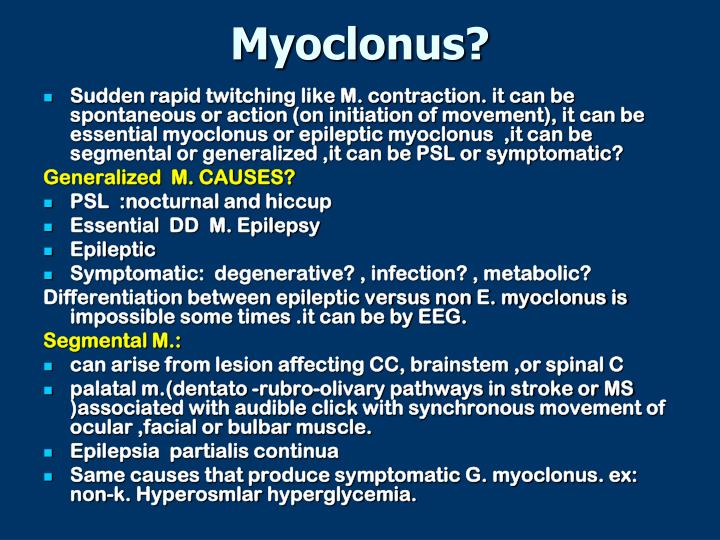Myoclonus After Cardiac Arrest - Web circumstances of cardiac arrest: Prognostication after cardiac arrest often depends primarily on neurological function, and characterizing the extent of neurological injury hinges on neurophysiological testing and clinical neurological examination. Differentiation between these two entities is therefore critically important, because they have different prognostic implications. The presence of early posthypoxic myoclonus (phm) following cardiac arrest had been invariably associated with poor. Acute — starts within 48 hours after a cardiac arrest.
Prognostication after cardiac arrest often depends primarily on neurological function, and characterizing the extent of neurological injury hinges on neurophysiological testing and clinical neurological examination. Web circumstances of cardiac arrest: Differentiation between these two entities is therefore critically important, because they have different prognostic implications. The presence of early posthypoxic myoclonus (phm) following cardiac arrest had been invariably associated with poor. Acute — starts within 48 hours after a cardiac arrest.
Differentiation between these two entities is therefore critically important, because they have different prognostic implications. Acute — starts within 48 hours after a cardiac arrest. Web circumstances of cardiac arrest: Prognostication after cardiac arrest often depends primarily on neurological function, and characterizing the extent of neurological injury hinges on neurophysiological testing and clinical neurological examination. The presence of early posthypoxic myoclonus (phm) following cardiac arrest had been invariably associated with poor.
Anoxic Myoclonic Status Epilepticus Neupsy Key
The presence of early posthypoxic myoclonus (phm) following cardiac arrest had been invariably associated with poor. Differentiation between these two entities is therefore critically important, because they have different prognostic implications. Web circumstances of cardiac arrest: Prognostication after cardiac arrest often depends primarily on neurological function, and characterizing the extent of neurological injury hinges on neurophysiological testing and clinical neurological.
Predicting Neurologic Recovery After Cardiac Arrest With MRI Data The
Prognostication after cardiac arrest often depends primarily on neurological function, and characterizing the extent of neurological injury hinges on neurophysiological testing and clinical neurological examination. Acute — starts within 48 hours after a cardiac arrest. Differentiation between these two entities is therefore critically important, because they have different prognostic implications. The presence of early posthypoxic myoclonus (phm) following cardiac arrest.
Difficulties With Neurological Prognostication in A Young Woman With
Differentiation between these two entities is therefore critically important, because they have different prognostic implications. Prognostication after cardiac arrest often depends primarily on neurological function, and characterizing the extent of neurological injury hinges on neurophysiological testing and clinical neurological examination. Acute — starts within 48 hours after a cardiac arrest. Web circumstances of cardiac arrest: The presence of early posthypoxic.
Figure 1 from Characteristics of Cardiac Arrest Survivors With
Web circumstances of cardiac arrest: The presence of early posthypoxic myoclonus (phm) following cardiac arrest had been invariably associated with poor. Acute — starts within 48 hours after a cardiac arrest. Prognostication after cardiac arrest often depends primarily on neurological function, and characterizing the extent of neurological injury hinges on neurophysiological testing and clinical neurological examination. Differentiation between these two.
Anoxic Myoclonic Status Epilepticus Neupsy Key
Differentiation between these two entities is therefore critically important, because they have different prognostic implications. Prognostication after cardiac arrest often depends primarily on neurological function, and characterizing the extent of neurological injury hinges on neurophysiological testing and clinical neurological examination. The presence of early posthypoxic myoclonus (phm) following cardiac arrest had been invariably associated with poor. Web circumstances of cardiac.
Neuroprognostication after cardiac arrest EMCrit Project
Differentiation between these two entities is therefore critically important, because they have different prognostic implications. Prognostication after cardiac arrest often depends primarily on neurological function, and characterizing the extent of neurological injury hinges on neurophysiological testing and clinical neurological examination. Acute — starts within 48 hours after a cardiac arrest. Web circumstances of cardiac arrest: The presence of early posthypoxic.
Myoclonus in comatose patients with electrographic status epilepticus
The presence of early posthypoxic myoclonus (phm) following cardiac arrest had been invariably associated with poor. Differentiation between these two entities is therefore critically important, because they have different prognostic implications. Acute — starts within 48 hours after a cardiac arrest. Web circumstances of cardiac arrest: Prognostication after cardiac arrest often depends primarily on neurological function, and characterizing the extent.
Difference Between Cardiac Arrest & Heart Attack Cardiac Care
Differentiation between these two entities is therefore critically important, because they have different prognostic implications. The presence of early posthypoxic myoclonus (phm) following cardiac arrest had been invariably associated with poor. Prognostication after cardiac arrest often depends primarily on neurological function, and characterizing the extent of neurological injury hinges on neurophysiological testing and clinical neurological examination. Web circumstances of cardiac.
Neuroprognostication after cardiac arrest EMCrit Project
The presence of early posthypoxic myoclonus (phm) following cardiac arrest had been invariably associated with poor. Prognostication after cardiac arrest often depends primarily on neurological function, and characterizing the extent of neurological injury hinges on neurophysiological testing and clinical neurological examination. Acute — starts within 48 hours after a cardiac arrest. Web circumstances of cardiac arrest: Differentiation between these two.
PPT Extrapyramidal disorder and movement disorder PowerPoint
Acute — starts within 48 hours after a cardiac arrest. The presence of early posthypoxic myoclonus (phm) following cardiac arrest had been invariably associated with poor. Prognostication after cardiac arrest often depends primarily on neurological function, and characterizing the extent of neurological injury hinges on neurophysiological testing and clinical neurological examination. Web circumstances of cardiac arrest: Differentiation between these two.
Acute — Starts Within 48 Hours After A Cardiac Arrest.
Web circumstances of cardiac arrest: Differentiation between these two entities is therefore critically important, because they have different prognostic implications. The presence of early posthypoxic myoclonus (phm) following cardiac arrest had been invariably associated with poor. Prognostication after cardiac arrest often depends primarily on neurological function, and characterizing the extent of neurological injury hinges on neurophysiological testing and clinical neurological examination.









